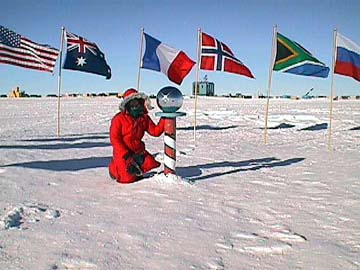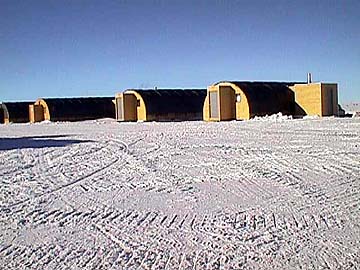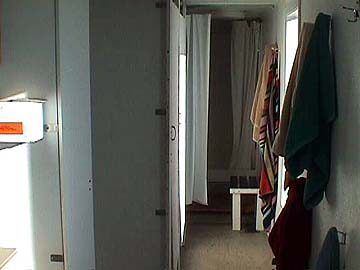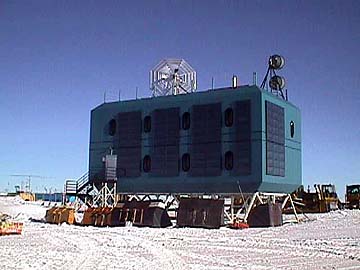
|
|
Nov. 27, 1998
Letter 3: Altitude and The First Day
Dear Everyone,
Whenever I give a presentation on my Antarctic experience, I ask my
audience if they would like to go to Antarctica. The responses are
invariably, pardon the pun, polarized. No matter which response you
may have, you must agree that stepping off the C130 on November second
facing the 12 flags of the ceremonial south pole with the geographical
south pole survey marker just beyond was a magical and awe inspiring
experience. Imagine the contrast of brilliant sunshine, the white of
the ice, and the chilling blue sky against the intense colors of the
flags of the 12 original treaty nations and you will understand the
beauty of that moment; of comprehending that I was privileged to have
an experience that not many will have.

This is me (Sandi) at the Ceremonial South Pole with the Elevated Dorm in the background.
Photo by Les Kolb.
It's not entirely honest to imply that I simply stepped off the C130.
I struggled off the C130 in huge cumbersome clothing, tugging at one
large orange carry-on bag in one hand with the other on the round
metal handrail while attempting to get each bunny boot to fit onto the
not wide enough metal steps in blinding brightness and finally
jolting to the ice in one piece. Along with the shock of the visual
was the simultaneous shock of the temperature. It was -120 F wind
chill. I cannot describe this coldness to you. We had arrived at the
beginning of a storm that was to last several days. With engines
running (they are not turned off here), our C130 off-loaded cargo and
returned to McMurdo.
Les and I trudged in the direction of the more buried than ever dome
fighting the bitter cold and already gasping for air through our polar
fleece neck gaiters. Knowing that we would eventually have to carry
our carry-on bags up out of the dome if we took them in, we left our
two bags on the ice in the gusting wind at the top of Heartbreak Hill,
the dozed out entrance to the dome. A few others followed our lead.
Once inside the dome that protects the orange prefabricated buildings
from the wind and drifting snow, we made our way to the Communications
department to say hello to our supervisor, BK, and colleagues we knew
from our last stint. After hugs all around, we went directly to the
galley for our briefing. We were thrilled to recognize many faces of
those we had worked with our previous austral summer. These brave
souls had wintered-over during which time a minimal staff remains here
unsupported during the long harsh night. Lots more hugs, glasses of
juice and lots of water, bowls of beef or veggie stew and fresh bread
welcomed us. Once we settled down, Dave, our Station Manager, and
Karen, Sr. Administrative Coordinator, gave us a very cordial and
welcoming briefing. They are proud of the ambiance of our station and
intend to promote it. It is a quality aided by our remoteness and
fairly small population.
For those of us working here just for the summer, housing is
predominately heated Quonset tents (called Jamesways) or heated
Quonset shaped prefabricated hypertats. The bathroom facilities,
called head modules, are in prefabricated and heated buildings around
100-150 feet away depending upon tent location. They contain a mens
and a womens with a shared washer and dryer. A rectangular two-story
space age blue building with a satellite antenna covered roof and
built up on criss-crossing steel girders to potentially prevent snow
from drifting has formerly housed solely scientists. We were amazed
and thrilled when Karen told us that we were assigned to this building
officially called The Elevated Dorm and unofficially called The Blue
Box or The Beaker Box (scientists are affectionately called "beakers"
here). Bathrooms are shared and down the hall or upstairs, but they
are inside! It also contains a small lounge with a kitchenette.
Since we were on the early flight, many rooms were vacant and we could
have our choice. We chose one of two of the smallest rooms that
contained only two beds in what we thought would be the quietest
location. Now, in retrospect, we do not believe there is such a thing
as a quiet sleeping space for "night" workers on the station. Even
though we have 24 hours of bright daylight and run a 24-hour station,
the majority of people are on "day" shift.

The Jamesways at summer camp.
Photo by Les Kolb.

Inside a summer camp bathroom prefabricated building (head module).
Photo by Les Kolb.

The Elevated Dorm where we live.
Photo by Les Kolb.
Les and I hung around the galley resting, drinking lots of water, and
casually talking with people. An hour and half later I was already
getting a bad headache and feeling like I was on a ship. After my
last experience with high altitude, I was not going to be in a hurry
to go anywhere. Eventually, we decided to make our way to our housing
which normally would be a 6-8 minute walk from the dome. We found a
banana sled (which looks like a banana with one side peeled) and Les
piled on 2 boxes that were waiting for us that we had mailed to
ourselves, and at the top of Heartbreak Hill our two solidly frozen
carry-on bags. We had to stop frequently to catch our breath in spite
of the stinging cold. Halfway to the Elevated Dorm my fingers began
to tingle and then hurt. I motioned to Les that I was going ahead
even though I was gasping for air. Before I made it to the dorm, my
hands went numb. As I attempted to grasp the metal railing of the
staircase to the dorm with hands that had lost feeling, I stumbled
twice catching my huge boots and on the metal grates. Struggling to
open the heavy freezer locker style door, I finally hooked my arm
through the latch and pulled it open. Lunging for the lounge just
beyond the double entry, I collapsed onto a chair with my head on the
table. Luckily a man was working in the lounge and unknown to me at
the time, Rich is the station Safety and Environmental Health
Coordinator. The first words out of my mouth were "I think I'm going
to throw-up." and the second were "My hands are numb." He whipped off
my heavy leather fleece lined gloves and my polypropylene glove liners
and began warming my hands in his. When Les arrived, he took over one
hand while Rich warmed the other. I have never experienced such
excruciating pain as the return of feeling in both of my hands.
Eventually I went horizontal on the couch, bunny boots and all, before
making my way to our room.
After making our beds with the sheets and 2 heavy gray wool blankets
and feather comforter given to each bed and filling the humidifier we
hand carried, we tried to get some rest. We napped fitfully due to
the extreme dryness and lack of oxygen while continuing to take Diamox
and drink water. Our headaches worsened in spite of the acetaminophen
kept by the galley microwave that Will, the station doctor, told us to
take when I called him from the galley. At one point I got out of bed
and couldn't stand up. I rested on the floor panting for air before I
was able to get back into bed. I fell asleep and when I woke up
again, I was able to move slowly around the room. The storm continued
to rage as the wind whipped the dry surface ice crystals through the
air greatly impairing visibility. Neither of us wanted to walk to the
dome. Les found a box of Ritz crackers that someone left in the
lounge and discovered the enormous drinking water container had
already been filled in preparation for station opening. We were well
set. Finally, 14 hours after being in the dorm and motivated by
hunger and the dinner hour as well as the need to show up for our
first night's work, we got dressed for our walk back to the dome. As
I searched my still frozen carry-on bag for my issued windbreaker
mittens (warmer than gloves), I was glad that I took the issued pair
of polypropylene glove liners even though they were too large. I
still wear two pair of glove liners under my mittens.
Even though the dorm is a short distance from the dome, visibility was
so poor we couldn't see it. I was thankful for the orange flagged
marker poles to guide us from the cargo yard near the elevated dorm to
the dome entrance. After a wonderfully delicious baked chicken
dinner, Les and I felt much better. Even though I would occasionally
feel like I was on a ship or have a headache days later, my little
bout with the altitude was a piece of cake compared to the previous
time I was here. Then I was in bio-med for 4 nights and 5 days before
I ever found my "room" in the Jamesway. BK told us to stay only as
long as we felt comfortable on our first night shift. We lasted until
about 4 a.m., but from thereafter have worked our entire shift. It
took awhile to switch over to day sleeping and our new eating
schedule. A few days later the storm subsided and as summer is
approaching, the temperatures are not nearly so severe.
At 9,450 feet, the Amundsen-Scott South Pole Station, at the
geographic South Pole, is on a polar plateau of 9,000 feet of ice that
drifts approximately 33 feet each year. Due to barometric pressure
changes, the actual physio-altitude varies greatly and can reach
11,000 to 13,000 feet. The average annual temperature is -56.9 F with
the record minimum of -117.0 F in June 1982 and the record maximum of
+7.5 F in December 1978. Precipitation is in the form of ice crystals
at 9 inches average annually with the average annual liquid equivalent
of 3.4 inches. Average wind speed is 10.8 knots.

Sandi Kolb in front of the Amundsen Scott South Pole Station dome.
Photo by Les Kolb.
Within our first week at the South Pole Station, Les and I each had a
miserable cold. In fact, Les was rather sick and Will was watching
him closely for pneumonia. Since then, we have both been great and
are gradually adjusting to the altitude. We are sleeping better and
are able to go up and down stairs and walk to the dome without
stopping for air. All in all, it really was a much easier adjustment
this second time around!
We had a lovely Thanksgiving dinner with much food and conversation
before beginning work tonight at 11:00 p.m. Yes, we had dinner for
breakfast but saved the pie for lunch since due to the holiday, there
was no midrats (midnight meal) tonight. Dinner was delicious even
though we couldn't eat too much of it for breakfast. We trust your
Thanksgiving was lovely, too.
Future topics include Extreme Cold Weather clothing, water, food, our
jobs, and the science research projects here.
The weekly climatological summary prepared by the station
meteorologists follows.
Best regards,
Sandi
Sandra Kolb,ASA
South Pole Station
PSC 468 Box 400
APO AP 96598-5400
Date: Fri, 13 Nov 1998 03:38:52 +1200
Subject: SOUTH POLE WEEKLY CLIMATOLOGICAL SUMMARY
Priority: normal
6 November 1998 through 12 November 1998 UTC
Temperatures:
Avg Temp...-42.7 (C) / -44.9 (F)
Max Temp...-37.5 (C) / -35.5 (F) on day 12
Min Temp...-47.1 (C) / -52.8 (F) on day 10
Sky Cover:
Avg Sky Cover (8ths)... 6
Days clear............. 1
Days partly cloudy..... 1
Days cloudy............ 5
Sunshine:
Sunset on 21 March, Sunrise on 23 September
Avg hours/day......... 17.0
Percent of possible... 70.9
Station Pressure (millibars):
Avg pressure........ 675.2 mbs
Highest pressure.... 678.6 mbs on day 8
Lowest pressure..... 670.6 mbs on day 10
Physio-altitude in feet and meters:
Average physio-alt = 10810 ft / 3295 m
Highest physio-alt = 10985 ft / 3348 m on day 10
Lowest physio-alt = 10681 ft / 3256 m on day 8
Visibility:
1 day with visibility of 1/4 mile or less.
Wind:
Avg wind speed............ 14.0 mph or 12.1 kts
Max gust.................. 29 mph or 25 kts on days 6 and 8
Max gust direction........ from grid North
Vectored wind direction... 021 degrees
Vectored wind speed....... 11.0 kts
Prevailing direction...... grid North
Balloon flight data:
Number of Soundings for the period... 14
Avg hgt of Soundings...... 124.0 mb
Highest Sounding.......... 9.2 mb, or 30344 meters
on day 6/12Z flight.
0 Soundings were missed.
8 Soundings were terminated due to balloon burst.
3 Soundings were terminated due to weak or fading signal.
1 Sounding was terminated due to ground equipment failure.
2 Soundings were terminated due to floating balloon.
**RECORDS**
No records were tied of broken during this period.
Back to Letters.
|
